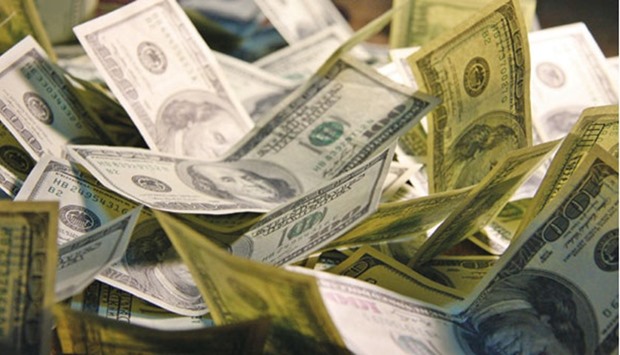Buy the dollar. Again. That’s the message for next year from the biggest banks trading in the $5.3-tn-a-day currency market.
Deutsche Bank, the world’s second-largest currency trader in Euromoney rankings, says the dollar’s rally has plenty of room to run - another two years, and about 10% on a trade-weighted basis. JPMorgan Chase & Co says the dollar will strengthen versus the currencies of New Zealand and Singapore, peaking in the second half of 2016. Goldman Sachs Group, Barclays and Credit Suisse Group are also bullish as the Federal Reserve moves toward raising interest rates for the first time in almost a decade.
“We expect broad dollar appreciation in 2016,” said Todd Elmer, a currency strategist in Singapore at Citigroup, which was first in the Euromoney rankings. “If the market moves to price in a steeper trajectory from the Fed, then that’s going to bring back the theme of cyclical and policy divergence between the US and other major economies.”
While the Bloomberg Dollar Spot Index has gained 9% this year, following an 11% advance in 2014, its ascent has been bumpy. Analysts cut forecasts last quarter due to weaker-than-estimated US economic data and a slowdown in China. Since October, the dollar rally has been reignited by Fed policy makers who said growth is robust enough to justify a rate increase at the central bank’s meeting.
Companies from Delta Air Lines to Whirlpool Corp have already blamed a stronger dollar for hurting overseas sales. With hedge funds and other large speculators holding bullish dollar futures positions close to an all-time high, the trade may be overcrowded and prone to reversal.
Recommended by: Deutsche Bank, Barclays, Goldman Sachs, BNP Paribas, Credit Suisse.
Foreign-exchange markets were dominated in 2015 by the idea that the US will boost rates in contrast with easing by the European Central Bank and other global peers. As the Fed tightens, the greenback may climb to parity with the shared currency in the second quarter, according to 17 of more than 60 analysts surveyed by Bloomberg.
After the ECB’s “disappointing” forward guidance, “policy ease will be held longer or be increased, meaning a deeper trough for euro-dollar,” wrote analysts led by Jose Wynne, head of foreign-exchange research at Barclays in New York. He expects the dollar to strengthen to 95 cents per euro by the end of next year.
Recommended by: Barclays, Morgan Stanley, BNP Paribas, Credit Suisse, Danske Bank.
The Australian dollar will remain one of the weakest Group- of-10 currencies next year, according to analysts led by Hans Redeker, Morgan Stanley’s head of global foreign-exchange strategy in London. That’s because “a rapidly changing Chinese economy, falling domestic terms of trade, weak competitiveness, shrinking rate differentials and external vulnerability” will drag down the currency.
The Aussie tumbled 12% against the US dollar this year as Chinese demand for iron ore, Australia’s biggest export, slumped.
Recommended by: UBS Group, BNP Paribas, Goldman Sachs, RBC Capital Markets.
“The Japanese economy faces significant challenges, with the inflation target remaining elusive, and continuing negative gross-domestic-product growth,” analysts including Daniel Waldman, co-head of foreign-exchange and rates strategy at UBS in New York, wrote in a report. Slowing exports may also drive the yen lower, he said.
Buying the dollar against the yen is the best way to make a bullish bet on rising US rates, according to Adam Cole, head of G-10 foreign-exchange strategy in London at RBC.
Recommended by: Bank of America, Barclays, Danske Bank.
China’s yuan may depreciate as much as 10% against the dollar in 2016 as the US boosts borrowing costs, according to David Woo, head of global rates and foreign-exchange strategy at Bank of America in New York. His favorite trade is a six- month forward contract to buy the dollar and sell the offshore yuan.

The dollar’s rally has plenty of room to run another two years, and about 10% on a trade-weighted basis


